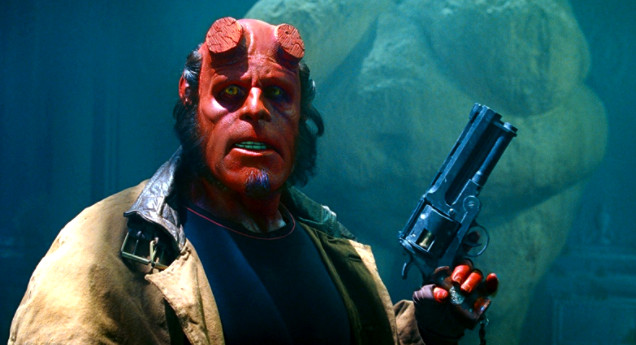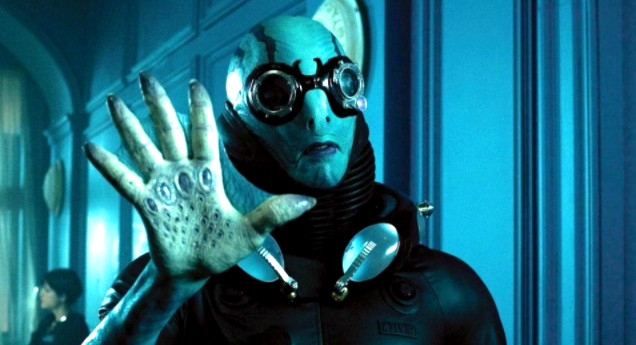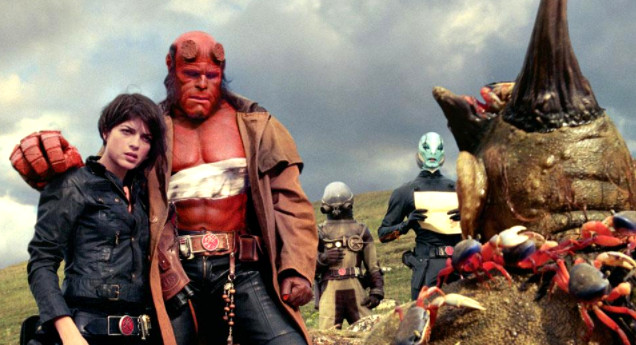It’s time to revisit the dark, ravishing beauty of Guillermo del Toro’s Hellboy movies

The words “Guillermo del Toro” have been used a lot lately in conjunction with “Academy Awards” and “Oscars hopeful.” Also of course with “The Shape of Water,” the title of the famous Mexican director’s latest outré work: an awards-coveted period drama capturing the emotional and erotic relationship between a mute woman and her alien fish boyfriend. It may be del Toro’s newest picture, but it’s not his best, and certainly not his most interesting.
Those distinctions belong to 2008’s Hellboy II: The Golden Army, which marked the second time a makeup-caked Ron Perlman starred as a buff, tomato red, human-like half-demon raised as a superhero fighting for humanity. You don’t, of course, win any Oscars (at least not the major ones) with a film named like that. Better to use a pretentious, lofty-sounding title – something like ‘The Colour of Oxygen’, ‘The Scent of A Bathtub’, or, as the case may be, ‘The Shape of Water’.
Now is a good time to revisit the Hellboy movies. Partly because they are so much better – more distinct, more idiosyncratic, more thoughtful – than the vast majority of superhero movies that fall off Hollywood’s assembly line. Also because they have a very clear through-line to The Shape of Water.
Amphibian Man, the gill-equipped lover romanced by lonely cleaner Elisa (Sally Hawkins) in del Toro’s new film, was obviously inspired by Hellboy’s amphibious sidekick Abe Sapien. This is clear just by taking a glance at both characters. It becomes clearer still when Elisa breaks the ice with Amphibian Man by giving him eggs, the same treats Abe (though he prefers his rotten) also finds delectable. Both characters are even played by the same actor, Doug Jones.

In terms of visually striking production design, few superhero movies are remotely comparable to the stunning surfaces of the Hellboy films. Del Toro is famous for his crazy looking creatures, such as that terrible, pallid, eyeballs-on-its-hands thing (Pale Man) in Pan’s Labyrinth. In that film the director distinguished fantasy from reality: the world visited through the looking glass, versus the harsh confines of reality.
In the Hellboy movies, fewer distinctions are drawn and more interesting connections made. Supernatural beings live among us and are housed in secret government labs. There are sightings of Hellboy in the same way there are sightings of the Loch Ness Monster and Bigfoot. If the hero didn’t exist in flesh and blood, in other words, he would exist in another form, a point reiterated when Hellboy is first introduced – in a scene showing him reading a comic book about himself (“They never get the eyes right”).
The character’s origins are linked to an attempt by Nazis to open a gateway to hell. It is historical revisionism on a similar footing as Quentin Tarantino’s Inglourious Basterds (cartoon and real-world, intellectual and hysterical) and a crystallization of what the core of the Hellboy films are about: the state of metamorphosis.
One hour into The Golden Army, a huge plant-like monster emerges, large as Godzilla, spinning vine-like tentacles and creating carnage, city slickers running for their lives. The scene could have been lifted from any number of metropolis-set creature features, at least for a little while. The moment becomes unusually textured when Hellboy has this strange thing beat, and prepares to kill it.
The key villain (Luke Goss) arrives and perches on a rooftop next to the hero, resembling Roy Batty about to talk about tears in the rain. He explains that the strange and beautiful beast tearing up the street is “the last of its kind…you destroy it, the world will never see its life again.”

This kind of city-demolishing monster, in this kind of movie, tend to be thoughtlessly cut down, existing only to be killed by the hero in a roar of bombast. A line like that shows a film that cares about its creations, even ones cursed to die in service of spectacle. It’s a line that could be directly inserted into 1933’s King Kong, still one of the greatest adventure films, and still the cinema’s most affecting picture of a natural unknown unleashed onto the everyday.
When Hellboy delivers the death blow and kills this weird thing, a green fluid oozes from the gargantuan creature’s body. Its legs turn into huge roots, from which flowers grow and a grass-like texture spreads across the street. Its head opens up, becoming a brilliant flower that blooms, sending a shower of green leaves and dust through the air. This scene is about how beautiful things can come from awful places, and how awful things can be beautiful. A state of metamorphosis.
In spirit and audacity, in the sudden switch from surreal ghoulishness to childlike wonder, from horror to hope in a heartbeat, the scene plays like a moment from a Studio Ghibli movie, rendered in live action – a great compliment for any film conjuring fantastical elements. I’m not sure I know which I like more: moments when the wit of the writing (the Hellboy movies are funny and sassy) rises to the surface, or the times when it is pushed deep below, allowing space for the set pieces to breathe and the themes to resonate.














